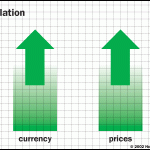Over the past several years, markets have responded to low  interest rates by pushing asset prices higher. Ostensibly, the purpose was to spark some inkling of inflation. Despite these efforts, rampant inflation has not materialized, but a growing chorus of forecasters see inflation pressures emerging. Even if that’s true, it should be welcomed – not feared. Here’s why.
interest rates by pushing asset prices higher. Ostensibly, the purpose was to spark some inkling of inflation. Despite these efforts, rampant inflation has not materialized, but a growing chorus of forecasters see inflation pressures emerging. Even if that’s true, it should be welcomed – not feared. Here’s why.
Written by Samuel Rines and Katherine Morille (RiskHedge.com).
One possible source of sustainable inflation pressures would be wage growth, however, for nearly 30 years, wage growth has been more or less non-existent—in part, as a result of a shift to service jobs and away from manufacturing and, in part, because we have entered an age in which automation is increasingly replacing human labor.
We are also in the midst of a demographic change of huge proportions: Baby Boomers are reaching retirement age and the younger Millennials are taking over. At least, that’s the theory. In practice, the process is slow, and Boomers are working longer than their parents did. The knowledge, or human capital, built up by the Boomers often results in higher salaries, and Millennials simply can’t replace them.
Since the financial crisis of 2007–2008, most monetary policy changes have been driven by hard data so, if wage growth is unlikely to be the force behind inflation, what will drive it?
The FOMC agrees that there’s a higher risk to the economy due to uncertainty surrounding the fiscal package. This uncertainty means the Fed will be patient in altering policy. The risk of disappointment is high, which could cause inflation expectations to drop—something the Fed does not want to happen.











Leave A Comment